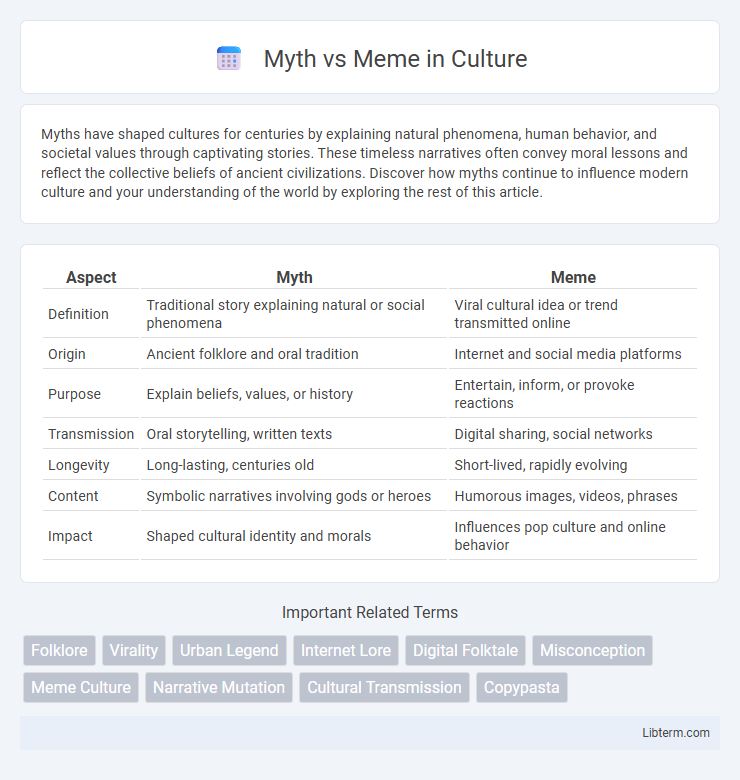Myths have shaped cultures for centuries by explaining natural phenomena, human behavior, and societal values through captivating stories. These timeless narratives often convey moral lessons and reflect the collective beliefs of ancient civilizations. Discover how myths continue to influence modern culture and your understanding of the world by exploring the rest of this article.
Table of Comparison
| Aspect | Myth | Meme |
|---|---|---|
| Definition | Traditional story explaining natural or social phenomena | Viral cultural idea or trend transmitted online |
| Origin | Ancient folklore and oral tradition | Internet and social media platforms |
| Purpose | Explain beliefs, values, or history | Entertain, inform, or provoke reactions |
| Transmission | Oral storytelling, written texts | Digital sharing, social networks |
| Longevity | Long-lasting, centuries old | Short-lived, rapidly evolving |
| Content | Symbolic narratives involving gods or heroes | Humorous images, videos, phrases |
| Impact | Shaped cultural identity and morals | Influences pop culture and online behavior |
Understanding the Concept: Myth vs Meme
Myths are traditional stories rooted in cultural beliefs, often explaining natural phenomena or historical events symbolically, while memes are units of cultural information that spread rapidly through modern digital platforms, reflecting contemporary social trends or humor. Understanding the concept of myth versus meme highlights how myths serve as enduring narratives shaping collective identities, whereas memes function as dynamic, replicable content evolving in real-time. This distinction clarifies the roles of each in transmitting culture: myths as foundational stories, memes as viral cultural artifacts.
Historical Origins of Myths and Memes
Myths originate from ancient oral traditions and cultural narratives, often serving to explain natural phenomena, human behavior, and societal values across civilizations. Memes, coined by Richard Dawkins in 1976, describe units of cultural transmission that evolve rapidly through imitation and digital sharing in modern society. While myths develop over centuries embedding deep symbolic meanings, memes spread swiftly in digital environments, reflecting contemporary cultural trends and collective communication.
Characteristics that Define Myths
Myths are traditional narratives rooted in ancient cultures, often explaining natural phenomena, origins, or customs through symbolic storytelling. They typically involve gods, heroes, or supernatural beings and convey moral or spiritual lessons. Unlike memes, myths serve as foundational cultural frameworks that shape collective identity and worldview.
What Makes a Meme in the Digital Age
A meme in the digital age is characterized by its rapid replication, adaptability, and cultural relevance across social media platforms, often evolving through user-generated variations that enhance relatability. Unlike traditional myths rooted in collective storytelling and historical context, memes thrive on immediacy, visual appeal, and humor to convey ideas quickly and memorably. The viral nature of digital memes is fueled by shared experiences, trending topics, and algorithm-driven exposure, making them a dynamic form of modern folklore.
How Myths and Memes Spread Through Cultures
Myths and memes propagate through cultures via storytelling and social transmission, shaping collective beliefs and behaviors. Myths often spread through oral traditions, religious practices, and literature, embedding themselves deeply in cultural identities. Memes disseminate rapidly across digital platforms, leveraging visual and textual formats to influence societal norms and trends.
The Role of Storytelling in Myths and Memes
Storytelling in myths and memes serves as a powerful tool for cultural transmission and social cohesion, with myths often conveying deep moral lessons and collective values through elaborate narratives. Memes utilize concise, highly relatable content to rapidly spread ideas and social commentary across digital platforms, reflecting contemporary societal trends. Both forms rely on storytelling to engage audiences emotionally and cognitively, shaping perceptions and shared identities in distinct yet complementary ways.
Impact on Society: Tradition vs Virality
Myths shape society by embedding cultural values and morals through generations, reinforcing tradition and collective identity. Memes drive rapid cultural evolution by spreading ideas instantly across digital platforms, influencing social behavior and trends in real time. The contrast highlights how myths preserve longstanding societal norms while memes accelerate cultural adaptation and virality.
Transformation: When Myths Become Memes
Myths undergo transformation into memes by condensing complex narratives into easily shareable, concise formats that emphasize relatable themes or moral lessons. This evolution enables ancient stories to adapt dynamically within digital cultures, fostering widespread engagement and reinterpretation across social media platforms. The memetic process distills myths into iconic symbols or phrases that resonate with contemporary audiences, ensuring their relevance and longevity.
Common Examples: Mythical Legends vs Viral Memes
Mythical legends like King Arthur and the Trojan Horse embody timeless narratives rooted in cultural heritage, often explaining natural phenomena or moral lessons through epic storytelling. Viral memes such as the "Distracted Boyfriend" or "Woman Yelling at a Cat" rapidly spread humor and social commentary across digital platforms, reflecting contemporary trends and collective internet culture. Both mediums serve as powerful vehicles for shared human expression, though myths preserve historical and cultural identity while memes capture fleeting, relatable moments in modern society.
Why “Myth vs Meme” Matters in Modern Discourse
Understanding the distinction between myth and meme is crucial in modern discourse because myths represent deeply rooted cultural narratives shaping identity and values, while memes function as rapidly evolving units of information that reflect and influence contemporary social trends. Recognizing how myths sustain collective memory helps analyze societal beliefs, whereas analyzing memes uncovers emerging ideas and grassroots communication patterns in digital environments. This differentiation enhances critical thinking and media literacy, enabling individuals to navigate the complexities of information dissemination and cultural impact in the digital age.
Myth Infographic

 libterm.com
libterm.com